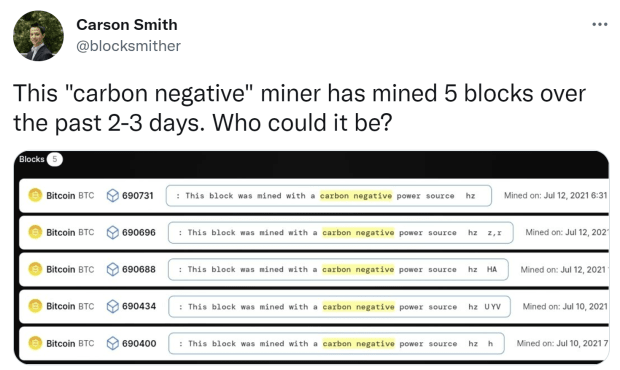A bitcoin miner has been presenting its blocks as “carbon negative.” But what does that mean for its energy use?
This is a guest post from Luxor’s Hashrate Index.
A miner with roughly 1 exahash (EH) of Bitcoin’s hash rate is advertising its blocks as “carbon negative.”
So, how can a miner produce work and leave a negative carbon footprint, seemingly reversing entropy?
Well, the short answer is, of course they can’t, but how can they claim carbon negativity at all?
It’s likely that the miner is using renewable energy to power their operations in addition to purchasing carbon credits/offsets. This one-two punch would take it from carbon neutrality to carbon negativity — on paper, that is.
In practice, it’s more complicated. Whether it be mining and refining lithium for solar panels, manufacturing steel and concrete for hydro dams or fabricating fiberglass for wind turbines, renewable infrastructure relies on fossil fuels in the manufacturing process. Even if it operate more-or-less green once erected, these renewable sources have large carbon footprints of their own.
For this miner’s purposes, though, the specifics are probably irrelevant. The miner in question likely just wants it on record that its operations are negative insofar as perceived government scrutiny or public perception are concerned.
If it is situated in North America (highly likely), the preventative measure falls in line with other miners on the continent who have made environmental, social and corporate governance (ESG)-friendly and/or 100% carbon neutral operations a major plank of their business platforms.
As climate change drives policy decisions in the decade to come, we expect miners, especially larger-scale, on-grid participants, to take measures similar to this one in order to appease the public and officials.
How Much Would It Cost To Be Carbon Negative?
Using Blue Sky’s figures for carbon emissions per energy source, we calculated how much carbon offsets would cost while running 1 EH of hash rate using popular renewables. We assume the miner consumes roughly 37 megawatts (MW) of power, is using new generation equipment and has an uptime of 98%.
Per energy source, carbon offset credits would add roughly following costs to a miner’s operating expenses:
- Solar: $579,000 per year
- Hydro: $22.1 per year
- Wind: $71,500 per year
Assuming the miner is self-mining with a power cost of $0.03 per kilowatt hour (kWh), its operating expenses without purchasing credits is roughly $9.5 million a year. A miner using a hosting facility with $0.06 per kWh would have roughly an annual operating expenses of $19 million.
This is a guest post by Colin Harper. Opinions expressed are entirely their own and do not necessarily reflect those of BTC Inc or Bitcoin Magazine.




